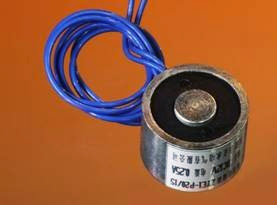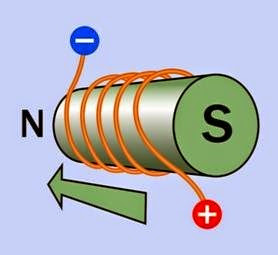The term electromagnet is used here to mean a coil containing a core of ferromagnetic material that does not move relative to the coil. The core is used solely to create a magnetic field that attracts or repels other parts that have appropriate inherent magnetic properties. Where a center component moves in response to the magnetic force created by current through a coil, this is discussed in the solenoid entry. By comparison, the inductor entry describes a coil that may or may not have a ferromagnetic core, and is used for the specific purpose of creating reactance, or self-inductance, in an electronic circuit, often in association with alternating current and in combination with resistors and/or capacitors. The inductor entry contains a basic discussion and explanation of magnetic force created by electricity.
An electromagnet consists of a coil that creates a magnetic field in response to an electric cur rent. The field is channeled and reinforced by a core of magnetic material (that is, material that can be magnetized). Electromagnets are incorporated in motors, generators, loudspeakers, microphones, and industrial-sized applications such as mag-lev trains. On their own, they pro vide a means for electric current to hold, lift, or move objects in which a magnetic field can be induced.
A very small, basic electromagnet about 1 inch in diameter is shown in Figure 20-1. No specific schematic symbol for an electromagnet exists, and the symbol for an induction coil with a solid core is often used instead, as shown in Figure 14-1 (the center variant of each of the three) in the inductor entry of this encyclopedia.
Figure 20-1. An electromagnet approximately 1 inch in di- ameter, rated to draw 0.25A at 12VDC.
How It Works
Electric current flowing through a circle of wire (or a series of connected loops that form a helix
169
Variants
electromagnetism > linear > electromagnet
or coil) will induce a magnetic field through the center. This is illustrated in the inductor entry of this encyclopedia, specifically in diagrams Figure 14-3, Figure 14-4, Figure 14-5, and
If a stationary piece of ferromagnetic material is placed in the center of the circle or coil, it enhances the magnetic force because the reluctance (magnetic resistance) of the material is much lower than the reluctance of air. The combination of the coil and the core is an electromagnet. This is illustrated in Figure 20-2. For a lengthier discussion of this effect, see “Magnetic Core” (page 122).
Figure 20-2. Direct conventional current flowing through a wire coiled around a ferromagnetic rod induces a mag- netic force in the rod, conventionally considered to flow from south to north.
The magnitude of the electromagnetic flux den sity will be proportional to the current flowing through the coil, assuming a DC power source.
Variants
Electromagnet designs vary according to their application. The simplest design consists of a sin gle coil wound around a rod which may terminate in a plate for applications such as lifting scrap metal. This design is relatively inefficient because the magnetic circuit is completed through air surrounding the electromagnet.
A more efficient, traditional design consists of a U-shaped core around which are wound one or two coils. If the U-shaped core is smoothly curved, it resembles a horse-shoe magnet, as shown in Figure 20-3. This design has become relatively uncommon, as it is cheaper to make windings across two separate, straight vertical cores and bridge them. However, the horseshoe configuration is extremely efficient, as the coils induce north and south magnetic polarities in the open ends of the U-shaped core, and the magnetic circuit is completed through any ob ject that is attracted toward the open ends and links them. The attracted object is shown as a rectangular plate in Figure 20-3. Because a mag neticcircuit will naturally attempt to limit its ex tent, and because this goal will be achieved when the circuit is completed, the attractive force of the U-shaped magnet is maximized.
An electromagnet powered by direct current naturally produces a consistently polarized, stable magnetic field. When AC current is applied, an electromagnet may still be used to exert an attractive force on a passive object that is not magnetized but is capable of being magnetized. The electromagnet will change its polarity at al most the same frequency as the AC, and will in duce equal and opposite fluctuating polarity in the target, causing mutual attraction. The core of the magnet will be composed of plates separated by thin layers of insulation to inhibit the eddy currents induced by the AC, but still an AC- powered electromagnet will be less efficient than a comparable DC-powered electromagnet because it will also suffer from hysteresis as power is consumed by repeatedly reversing the polarity of the magnetic domains in the core.
Some electromagnets that are described as suit able for AC power actually contain rectifiers that convert the AC to DC.
Figure 20-3. This traditional design for an electromagnet has a pedigree stretching back for more than a century. It maximizes efficiency by completing a magnetic circuit through any object that the magnet attracts.
Values
Electromagnets are typically calibrated in terms of their power consumption and retaining force (the weight of an iron target that they can sup port). The retaining force is usually measured in grams or kilograms.
How to Use it
Electromagnets are used mostly as subassem blies in other components, such as motors and generators, relays, loudspeakers, and disk drives. They have also been used in audio (and video) tape recorders to magnetize ferric oxide on tape, using a magnetic field of varying strength to re cord an audio signal. In this application, a form of horseshoe magnet with an extremely narrow gap is used, the width of the gap determining the highest frequency that the electromagnet can record, in conjunction with the speed of the tape moving past the head.
The tape recording process can be reversed when the electromagnet “reads” the tape and turns the signal back into a weak alternating cur rent that can be amplified and reproduced through a loudspeaker.
A simple application for an electromagnet is in a traditional-style doorbell, where one or two coils attract a spring-loaded lever, at the top of which is a knob that hits a bell. When the lever is pulled toward the bell, it breaks a contact that supplies power to the electromagnet. This allows the lever to spring back to its original position, which re- establishes the circuit, repeating the process for as long as power is applied to the bell. The bulk and weight of the component parts in this type of doorbell are making it obsolete, as electronic versions containing small loudspeakers become relatively cheaper. However, a solenoid may still be used in the type of bell that creates a single chime or pair of chimes.
In any device using a cathode-ray tube, electro magnetic coils are used to form a yoke around the neck of the tube, to deflect the beam of elec trons on its way to the screen. A similar principle is used in electron microscopes. In some cases, electrostatically charged plates are used to ach ieve the same purpose.
An electromagnet may be used to activate a reed switch (the diagram in Figure 9-7 shows such a switch). In this application, the combination of the electromagnet and the switch are function ing as a relay.
When an electromagnet is energized by alter nating current, it can be used to degauss (in other words, to demagnetize) other objects. The AC is either applied with diminishing current, so that the alternating magnetic polarities gradually subside to zero, or the electromagnet is gradually moved away from the target, again reducing the magnetic influence to (virtually) zero. This latter procedure may be used periodically to demag netize record and replay heads on tape recorders, which otherwise tend to acquire residual mag netism, inducing background hiss on the tape.
Traditional large-scale applications for electro magnets tend to involve lifting and moving heavy objects or scrap metal, such as junked cars. A more modern application is in magnetic reso nance imaging (MRI), which has revolutionized some areas of medicine.
Very large-scale applications for electromagnets include particle accelerators, in which multiple magnetic coils are energized sequentially, and fusion-power generators, where high- temperature plasma is contained by a magnetic field.
What Can Go Wrong
Because an electromagnet requires constant power to maintain its magnetic force, yet it is not doing any actual work so long as its target re mains stationary (in contact with the core of the magnet), the current running through the coil of the magnet must be dissipated entirely as heat. Further discussion of this issue will be found at “Heat” (page 177) in the solenoid section of this encyclopedia.



